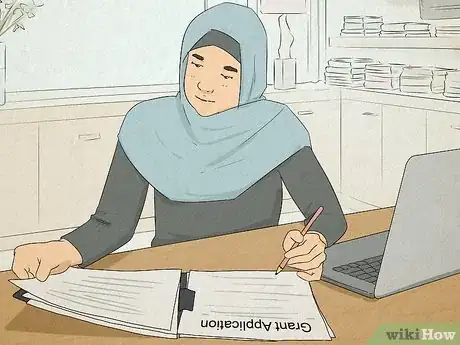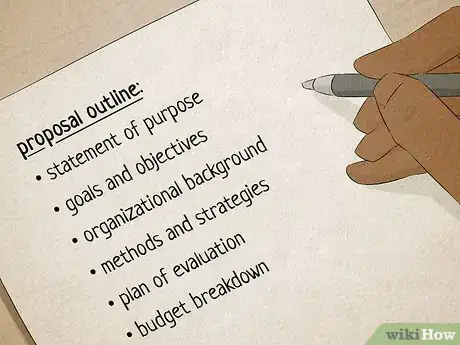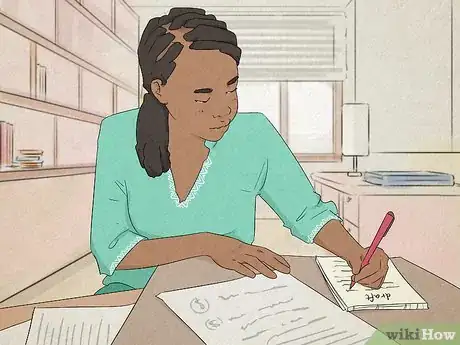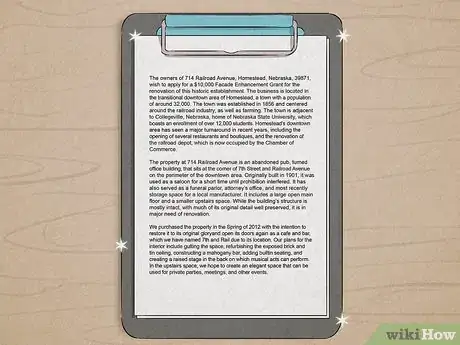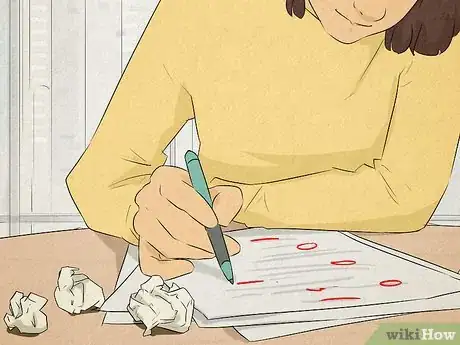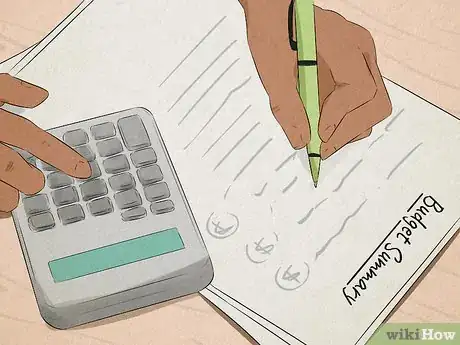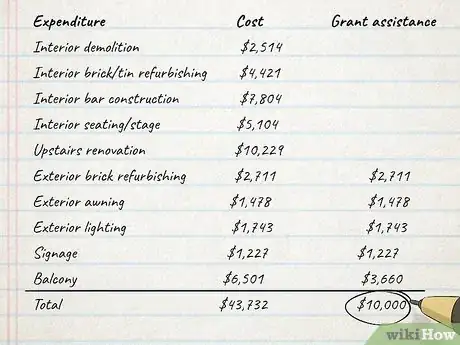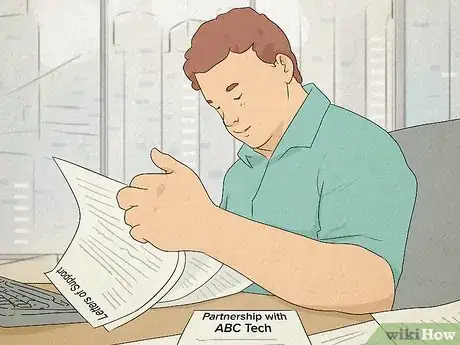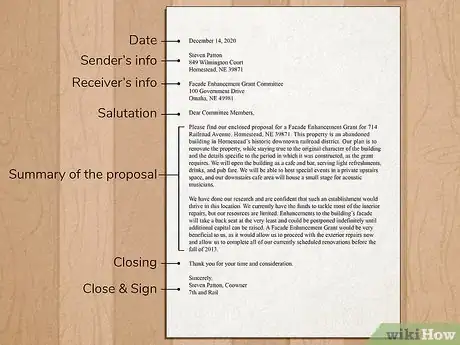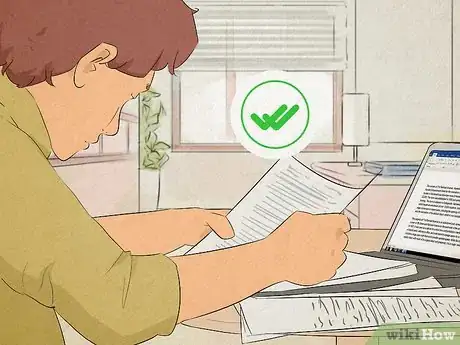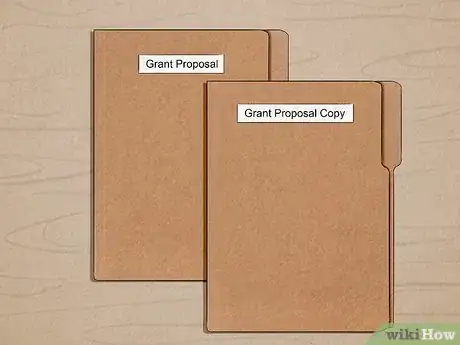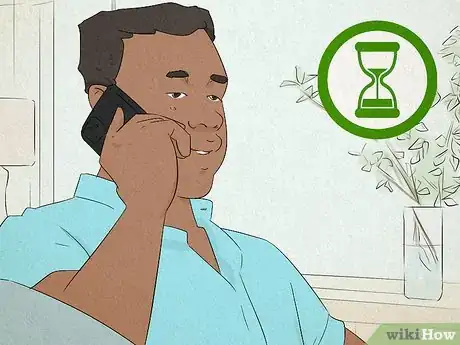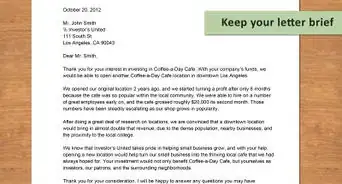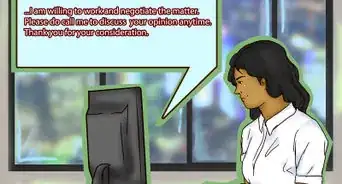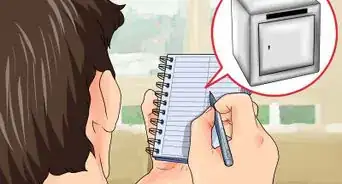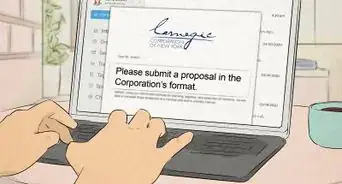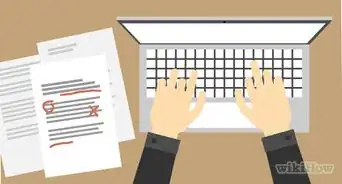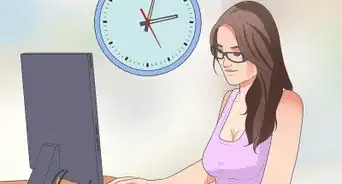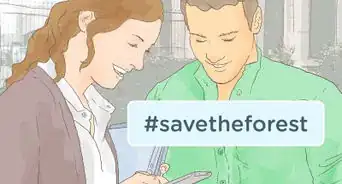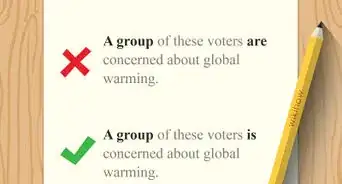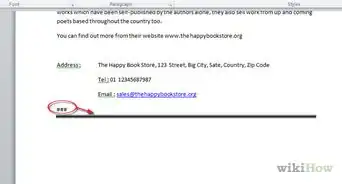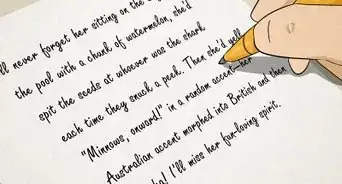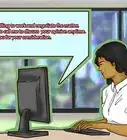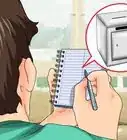This article was co-authored by Michelle Golden, PhD. Michelle Golden is an English teacher in Athens, Georgia. She received her MA in Language Arts Teacher Education in 2008 and received her PhD in English from Georgia State University in 2015.
There are 9 references cited in this article, which can be found at the bottom of the page.
wikiHow marks an article as reader-approved once it receives enough positive feedback. This article received 19 testimonials and 94% of readers who voted found it helpful, earning it our reader-approved status.
This article has been viewed 1,245,333 times.
True grants can be very difficult to find and harder still to get. It may not be easy to find the right grant, but when you do, properly completing the grant application will be your biggest challenge. Most grant applications ask for similar information, but they often have different formats. Some will have a list of questions. Others will ask for a “narrative”—the story of your project. Whether it's for a business or organization, writing a grant proposal is a skill that you can learn.
Steps
Sample Grant Proposal Documents
Getting Started
-
1Read the grant application carefully. Highlight all questions you must answer and materials you have to include. Underline key words or phrases you might want to use.[1]
- Assess the purpose the grant is intended to fulfill. Throughout the process, you'll want to make sure to highlight your organization's contribution to this purpose, both in the past and in the present.[2]
- For example, if the grant is intended to promote education, you'll want to make sure to highlight your organization's educational activities, donations, etc.
- Before you start writing—brainstorm. What are the strong points of your organization? Your program? What are your best arguments and examples? These ideas give you a place to start writing.[3]
-
2Write a summary statement. Start by writing a one-paragraph description of your request. This will help you start with the big picture—the rest is filling in the details. You may be able to use this summary in the proposal, or as the first paragraph of your narrative. It should include:
- Who you are, explained as if the grantor has never heard of your organization before.[4]
- What your project is, and specifically what you plan to do.[5]
- How much you’re asking for, and exactly what you'll use the money for.[6]
- If the grant requires an abstract, this summary statement will serve as your first draft.
Advertisement -
3Create an outline. It should describe each step of your plan and organize your thinking. The outline is the plan you'll follow as you draft your proposal.[7]
- Expand each point as needed to fully explain each section.
- Use the grantor's request for proposals (RFP) or criteria as the basis. The outline should follow, painstakingly, the sequence and terms prescribed by the grantor.
-
4Determine if your proposal is the type of project the grantor actually funds. Don't assume that just because there is a significant amount of money available, that they will fund just anything.[8]
- The truth is that grantors are usually very specific in what they are looking for (and sometimes a bit odd, but that's their choice), and will rarely deviate from their category.
- You may have the very best purple widget in the world, but if the grant is only for the producers of red widgets, you won't get the grant.
Writing Your Proposal
-
1Write the first draft. It doesn't have to look good, just get your ideas down on paper—you can polish them later.[9]
- Look at your brainstorm ideas and your outline, and start with the questions that you have the most answers for. If you get stuck on one question, work on another one for a while.[10]
- Focus on the parts of your project that they’ll like best—use their guidelines for clues. For example, if they're partial to environmental responsibility, and part of your project is using renewable resources for energy, make that stand out.
- Where appropriate, highlight your organization's partnerships with other groups. This builds credibility and legitimacy.
-
2Clearly lay out specific goals. Your grant proposal should describe what the money will be used for, and the clearer you are in describing your goals, the more likely the outcome of your proposal will be positive.[11]
- If you say, for example, "I want this grant so that I can help the community," you won't get nearly the credibility as you would by saying "This grant will allow us to buy two new computers, and create two part-time paid staff positions in an area where jobs for high school students are very difficult to find."
-
3Make it shine. When you’re done with your draft, go through it carefully and polish it up. Make sure the ideas are clear and the delivery concise. Read it out loud to see how it flows. You will probably need to rewrite a lot, and possibly will need to do so several times.[12] [13]
- You can use the key words and phrases you underlined in the application. But don’t worry about getting fancy—just say what you have to say, briefly and clearly.
- Review your original summary. Make sure it exactly reflects the proposal you've actually written—your ideas might have changed!
-
4Review the proposal and the requirements. Before you proofread, read and re-read the requirements instructions carefully. Every grant has rules and procedures that must be followed exactly as written. Make sure your proposal has followed all the rules.[14]
- If it says that the grant must be submitted via the online form, don't even bother to ask if you can send it via fax.
- Unlike employment applications, in which it sometimes pays to be original, grant committees have rules in place for a specific reason, and they expect them to be followed to the letter. To do otherwise may mean that your application will be disqualified before it ever gets read.
-
5Proofread carefully. Show the funding committee that you take the proposal seriously by carefully proofing your proposal for spelling, typing, and grammatical errors.
- Take time to have at least two people proofread your proposal before you submit it—and then read it out loud to yourself to make sure.[15] Some say reading something from back to front is a good way to catch errors you might otherwise miss, but do whatever you must to make certain you are submitting a flawless document.
-
6Do a reality check. Have at least two other people outside of your organization or discipline read the proposal, and then ask them questions about your concept.
- If they cannot explain what you are trying to do, chances are the grants committee won't either, and they won't fund what they can't comprehend.
Adding Required Support Documentation
-
1Define the project's budget. Don't guess about the numbers. Instead, take the time to research and evaluate the actual expenses you've got to manage. Don't estimate. Use real numbers, not amounts that end in 000.00.[16]
- In a grant proposal, guessing won’t make it. If a grant reviewer suspects that your financial sheet is not accurate, they don't have either the time or the inclination to do the research—you just lost the grant.
- Find out exactly what kind of equipment, labor, and anything else you are going to need, and exactly what the cost will be so you can spell it out in the proposal.
-
2Produce a budget summary. A budget summary is a document that summarizes personnel expenses by category such as salary and fringes, purchased services, supplies, occupancy related expenses, communications, travel, equipment, printing, capital, indirect costs, etc.[17]
- Typically, you will allocate the summary across several columns of information: total project cost, amount sought from the funder, and the matching funds you are contributing.
- Grantors are more likely to consider proposals that show the applicant is also has a stake in the outcome.
- Do not use a line called "other expenses" unless you fully explain it.
-
3Create a budget justification. A budget justification provides numerical detail explaining how you arrived at the amounts in the summary.[18]
- In all circumstances, make sure your amounts balance out, meaning that everything adds up to the same numbers throughout the proposal.
-
4Show that your participation matters. Letters of support and newspaper articles document your success and your partnerships with other organizations, and go a long way toward establishing your validity.
-
5Add other documents as required. For example, a 501(c)(3) letter of tax-exemption; an audit or financial report, and a list of the board of directors. Make a file with several copies of each, so you have them ready whenever you write a proposal.
Finalizing Your Application
-
1Add a cover letter. This should include a summary of your request, including the purpose of your project and the amount of money you are requesting. It should also list the contents of your proposal (i.e. which documents you have included).
- Your cover letter will, in many cases, provide your grantor with their first impression of you. You should invest as much time and care in the cover letter as the other parts of the document.
-
2Proofread everything—again. You may think the document has been thoroughly proofread, but do it again anyway. It's not unusual for a word to be misspelled and have nobody catch it.
- Keep a look out for small details, such as a "there" that should be "their," an "it's" that should be "its," or a word that is commonly misspelled.
-
3Double check everything. Make sure you answered all the questions and are sending all the required materials.
-
4Make a copy for your files. The information you've compiled could be very valuable for future grant applications.
-
5Make sure you mail or deliver it in time to meet the deadline. A late application will look sloppy, and may not even be considered.[19]
Following Up
-
1Give it a little time. About a week after mailing, call to make sure it arrived and is complete (this is also an opportunity to talk a bit with the grant maker).[20]
-
2Keep the grantor informed. During the review period, if you have a major success, send a letter and let them know. If you get an article in the paper or online, send them a copy or the URL.
-
3Be patient. The review process can take a long time. The fact that you haven't heard anything is not necessarily a sign of anything.[21]
Community Q&A
-
QuestionWhere do I get a grant application?
 Community AnswerThe government from the federal to the states, and even each local community offers some form of grants. Schools offer grants otherwise known as scholarships. Additionally, specialized grants for different needs can be found by detailing your needs in a search on the internet for the area. One last item is sponsorship grants.
Community AnswerThe government from the federal to the states, and even each local community offers some form of grants. Schools offer grants otherwise known as scholarships. Additionally, specialized grants for different needs can be found by detailing your needs in a search on the internet for the area. One last item is sponsorship grants. -
QuestionHow often does a for-profit startup get funding?
 Community AnswerYou are the driving force to receive anything in financing, if you aren't driven (so very passionate) to ask complete strangers, friends, or relatives for the funds you need, then you won't see any funds in to your account. But if you apply your good charm and grace and sell your idea to many then you will find that one person or many who will come forward and be willing to hand over any money to place into your startups bank account. Availability of funds depends on many variables including the current political condition of the country you live in.
Community AnswerYou are the driving force to receive anything in financing, if you aren't driven (so very passionate) to ask complete strangers, friends, or relatives for the funds you need, then you won't see any funds in to your account. But if you apply your good charm and grace and sell your idea to many then you will find that one person or many who will come forward and be willing to hand over any money to place into your startups bank account. Availability of funds depends on many variables including the current political condition of the country you live in. -
QuestionWhere can I find a grant for a nonprofit charity?
 Community AnswerThat depends entirely on what type of work the nonprofit charity has historically done and/or is interested in doing in the future. For example, an international nonprofit involved with healthcare infrastructure in developing countries might contact the Bill and Melinda Gates Foundation. A nonprofit operating a city homeless shelter and/or food bank might research grant options from the city, state, or county governments, or perhaps from local religious institutions. Part of the process is discerning the nonprofit's field of expertise and impact, then networking with appropriate funding sources.
Community AnswerThat depends entirely on what type of work the nonprofit charity has historically done and/or is interested in doing in the future. For example, an international nonprofit involved with healthcare infrastructure in developing countries might contact the Bill and Melinda Gates Foundation. A nonprofit operating a city homeless shelter and/or food bank might research grant options from the city, state, or county governments, or perhaps from local religious institutions. Part of the process is discerning the nonprofit's field of expertise and impact, then networking with appropriate funding sources.
References
- ↑ http://governmentgrant.com/grant-writing/how-to-write-grant-proposal
- ↑ http://ctb.ku.edu/en/writing-grant-application
- ↑ http://governmentgrant.com/grant-writing/how-to-write-grant-proposal
- ↑ https://www.bauer.uh.edu/career-center/docs/career-guides-resources/How-to-Write-a-Summary-Statement.pdf
- ↑ http://ctb.ku.edu/en/writing-grant-application.
- ↑ https://www.instrumentl.com/blog/how-to-write-executive-summaries-for-grants
- ↑ http://www.wwcc.edu/CMS/fileadmin/PDF/Learning_Center/10-28___29-2014_Jessica_Cook_Writing_Successful_Grant_Proposals_-_Day_2.pdf
- ↑ https://www.instrumentl.com/blog/how-to-write-executive-summaries-for-grants
- ↑ http://www.proposalworks.com/proposal-writing-tips/first_draft
- ↑ http://www.proposalworks.com/proposal-writing-tips/first_draft
- ↑ http://ctb.ku.edu/en/writing-grant-application
- ↑ http://governmentgrant.com/grant-writing/how-to-write-grant-proposal
- ↑ http://www.proposalworks.com/proposal-writing-tips/first_draft
- ↑ https://www.grants.gov/learn-grants/grant-policies.html
- ↑ http://governmentgrant.com/grant-writing/how-to-write-grant-proposal
- ↑ http://governmentgrant.com/grant-writing/how-to-write-grant-proposal
- ↑ http://ctb.ku.edu/en/writing-grant-application
- ↑ http://ctb.ku.edu/en/writing-grant-application
- ↑ http://writingcenter.unc.edu/handouts/grant-proposals-or-give-me-the-money/
- ↑ http://ctb.ku.edu/en/writing-grant-application
- ↑ http://governmentgrant.com/grant-writing/how-to-write-grant-proposal
- ↑ http://writingcenter.unc.edu/handouts/grant-proposals-or-give-me-the-money/
About This Article
If you need to write a grant proposal to apply for a grant, start by carefully reading the grant application. Highlight any questions you must answer and materials you must include in your proposal. When you’re ready to start writing, open with a one-paragraph statement summarizing who you are, what your project is, how much you’re asking for, and what you’ll use the money for. Next, go into detail about each step of your plan, using the grantor’s request for proposals, or RFP, as a guideline. For tips from our reviewer on how to produce a budget summary, keep reading!



